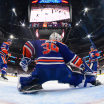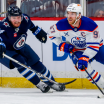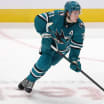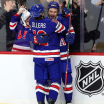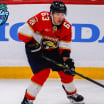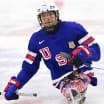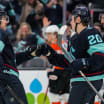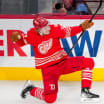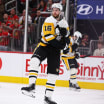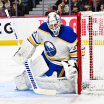TORONTO-- The evolution of Auston Matthews takes place partly in one-on-one video sessions with Toronto Maple Leafs coach Mike Babcock.
The other day, Babcock showed Matthews clips of Pittsburgh Penguins captain Sidney Crosby, whom he has coached with Canada in two Olympics and with Team Canada in the World Cup of Hockey 2016. A couple of days earlier, Babcock showed Matthews clips of Detroit Red Wings captain Henrik Zetterberg, whom he coached for 10 seasons in Detroit.
Auston Matthews evolving into more complete player
Maple Leafs working to make prized rookie into dominant two-way center
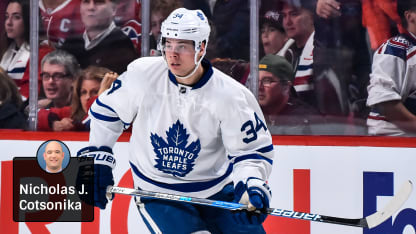
Babcock did not show Matthews the kind of highlights of Crosby and Zetterberg you would see on TV. He was not trying to boost Matthews' offensive production, not directly, anyway.
He showed him details that helped Babcock win championships -- two Olympic gold medals and a World Cup with Crosby, a Stanley Cup with Zetterberg -- the kind of details that have made Crosby and Zetterberg top two-way centers.
He showed him how Crosby got the puck, drew his opponent to him, got his opponent out of position and made the play instead of overhandling the puck. He showed him how Zetterberg got the puck back three times simply by standing in the right spot.
"We need him to be a dominant, dominant center for us," Babcock said Tuesday when the Maple Leafs prepared to host the Nashville Predators (7:30 p.m. ET; TVAS, SNO, FSN-TN). "We think he's going to be by Christmastime. We think he's a very good player already, but we think he can be lights out both with and without the puck. You know he takes a lot of pride."
Matthews is no ordinary rookie. He played professionally in Switzerland last season. He played for the United States in the IIHF World Championship in the spring. He was the No. 1 pick of the 2016 NHL Draft. He played wing on a line with Connor McDavid and Mark Scheifele for Team North America in the World Cup of Hockey 2016, showing he could skate and think with the best against the best.
But this is the NHL, not Switzerland or the worlds, and he isn't on the wing with McDavid and Scheifele in Toronto. He's centering guys like Connor Brown and Zach Hyman. And he's 19 years old. Though he had four goals in his NHL debut, though he has played well lately, he has two assists in his past nine games.
The good thing is he and his coaches are focused on the process and the long term, not the short term.
"Obviously I'm used to scoring," Matthews said. "That's what I want to do. Obviously when those chances aren't going in, you're hitting a lot of posts, you get frustrated.
"So I think they're doing a pretty good job of just keeping it light. Nothing crazy. No video of, 'You've got to shoot the puck 3 inches lower and it'll go in,' and stuff like that. They've been great throughout this whole thing.
"Most of the time you talk, you watch video on defensive stuff, defensive play. I think that's the most important thing, especially coming in your rookie season, playing the center position. That's pretty tough."
Babcock could have started Matthews on the wing with, say, Nazem Kadri.
"When you come to the National Hockey League and they let you be a winger for a couple years, you learn how to play," Babcock said. "It's way easier."
But he didn't. Why?
"Well, I just think he's that good," Babcock said.
Matthews is ready physically at 6 feet 3, 216 pounds, and he's ready mentally even at his young age and even in the fishbowl of Toronto. He's mature beyond his years and living with his father, which helps keep him grounded. He spoke to a large group of reporters for a long time Tuesday morning, as he often does, and said he was "very comfortable" in the spotlight.
Babcock feels Matthews can handle learning on the fly and make progress quickly in this environment. He already sees it. He pointed out how Matthews' faceoff percentage was 44 percent over his first five games, 50 in his second five and 55 in his third five.
"So what he's telling you already, he likes having the puck," Babcock said. "He's sick and tired of chasing it already. So then the next thing he's going to figure out is if he stops in the right places on defense and puts his stick in the right places, the offensive players are going to keep giving it back to him, and his skill set's going to come out. …
"The hardest part for a kid when you come to the National Hockey League is, you never get the puck. You work on all this stuff."
Babcock referenced a story on NHL.com in which Arizona Coyotes captain Shane Doan talked about the importance of his young teammates learning to play without the puck. Doan said the sole focus of young players in general was skill. They were amazing stickhandlers and shooters. Problem was, they had the puck on their stick 30 seconds a game.
"They've got all these skill coaches, and they've got a fitness coach and all this," Babcock said. "But they don't [have] a guy who tells you to stop in the right spot so you can get the puck back. So you get out there and you got all these skills, but you never get to use any of them because you never get the puck."
Matthews has a guy telling him to stop in the right spot. He's going to have the puck on his stick in Toronto for a long, long time.



